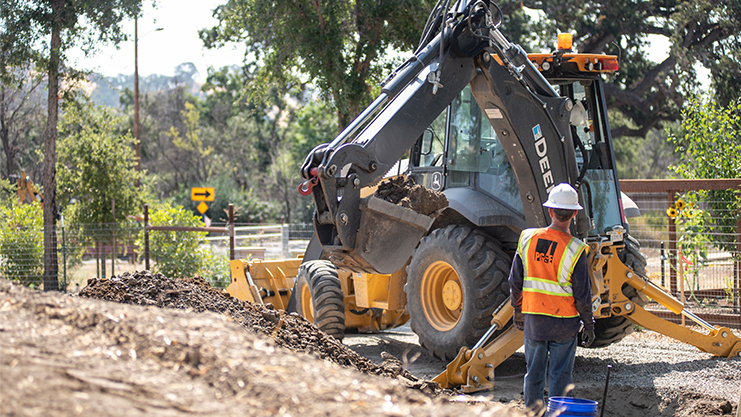Undergrounding and system upgrade projects are typically completed in 12-24 months. System upgrade projects include installing strong poles and covered powerlines. Projects in your community may already be in one of the below phases*:
Error: Field cannot be left blank.
Error: Invalid entry. Do not use equal signs [=] or colons [:].
This summary is not available. For more details, open this PDF.
- Still need assistance? Try the Help Center.
- Link accounts. Learn how to link your accounts or access more accounts.
- CARE. Find out if you qualify for a discount.
- Medical Baseline. Learn how to apply.
- Rebates. Explore PG&E rebates for your home.
- Outages. Report and view electric outages.
- Jobs/Careers. Find out about jobs at PG&E.
Error: Field cannot be left blank.
Error: Invalid entry. Do not use equal signs [=] or colons [:].
This summary is not available. For more details, open this PDF.
- Still need assistance? Try the Help Center.
- Link accounts. Learn how to link your accounts or access more accounts.
- CARE. Find out if you qualify for a discount.
- Medical Baseline. Learn how to apply.
- Rebates. Explore PG&E rebates for your home.
- Outages. Report and view electric outages.
- Jobs/Careers. Find out about jobs at PG&E.
Undergrounding & system upgrades
Learn more about our undergrounding work
Here's what to expect in your area.
How we determine where to complete wildfire safety work
The types of system improvements we consider include:
- Moving powerlines underground
- Installing strong poles
- Covering powerlines
- Trimming trees
These are just some of the layers of protection that help keep customers safe. Learn more about our other layers of wildfire protection. Visit PG&E's Community Wildfire Safety Program.
Benefits of undergrounding for wildfire safety
Our undergrounding efforts involve moving sections of powerlines below ground. This eliminates nearly all wildfire ignition risk from that line. It also improves reliability.
Undergrounding is safe, strong and more cost-effective in the long term. This proven process:
- Reduces nearly all wildfire risk in a given location
- Improves reliability and limits outages
- Decreases the need for future tree and vegetation work
- Lowers maintenance and operating costs
Note: After we complete this work, customers will continue to see other equipment overhead. In most cases, this includes telephone lines or lower-voltage powerlines connecting to individual homes or businesses.
Benefits of system upgrades for wildfire safety
We are upgrading overhead poles and powerlines to reduce wildfire risk. We describe these changes as system upgrades, or overhead hardening. This work reduces ignition risk by nearly 67% on a line once completed. When used with other wildfire safety tools, additional risk is reduced. It is also a useful tool in areas where powerlines cannot be moved underground.
These efforts are targeted in high wildfire-risk areas and can include:
- Replacing bare powerlines with strong covered powerlines
- Installing strong poles
- Installing more poles to support the weight of covered powerlines
- Removing overhead poles and lines that are no longer needed
Note: After we complete this work, customers may also see remaining poles for phone, internet or other electrical lines.
What can I expect during this work?
What to expect:
- Crews walking your neighborhood to identify and mark potential project routes.
- Survey crews painting and staking.
Watch our video about what to expect for potential undergrounding projects during the scoping and surveying phase. Audio description | Transcript (PDF)
You can also download our wildfire safety system assessments and surveys fact sheet (PDF) for more information.
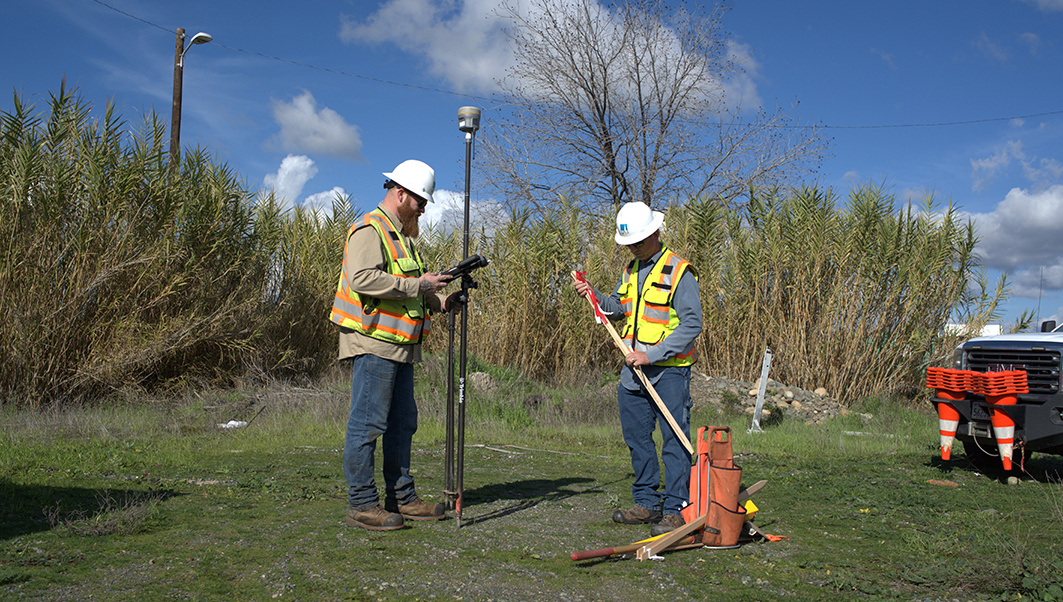
What to expect:
- Crews preparing project sites for inspection.
- PG&E representatives meeting with property owners about easements.
- PG&E representatives performing soil samples and inspecting vegetation.
Watch our video about what to expect during the design phase. Audio description | Transcript (PDF)
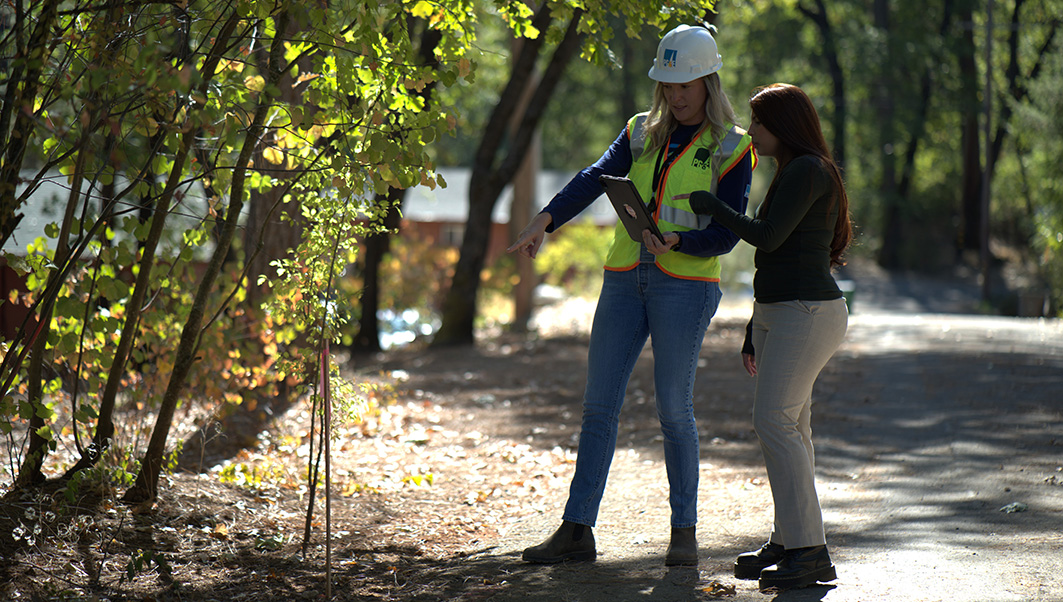
What to expect:
- Crews trimming or cutting down trees and shrubs.
- Construction to install new equipment.
- Traffic control measures will be in place to keep you safe.
Depending on the work being done in your area, watch our video about what to expect during system upgrades work or undergrounding work.
Audio description | Transcript (PDF)
Audio description | Transcript (PDF)
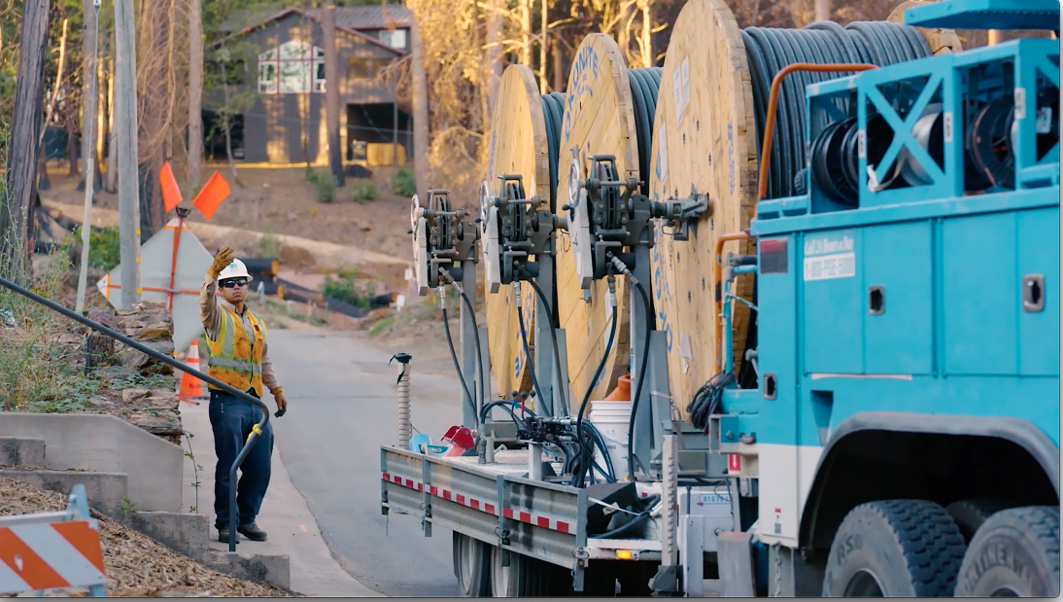
What to expect:
- PG&E representatives working to install and energize upgraded powerlines.
- Your power may need to be turned off for a short time to complete this work safely.
View traffic control measures in your area.
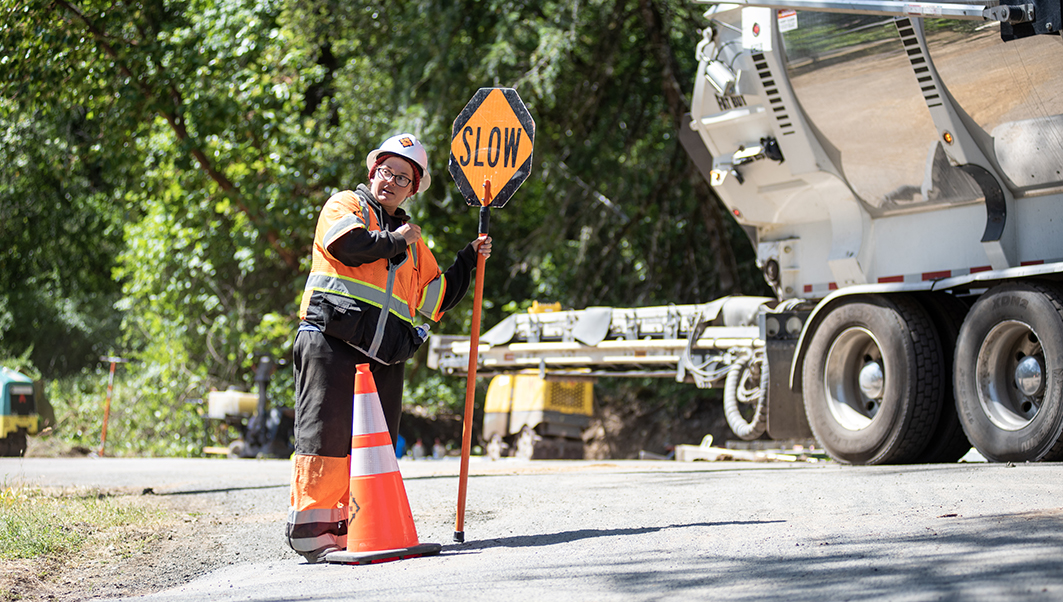
What to expect:
- Crews working to restore the area.
- Crews removing any remaining construction equipment or materials.
- Crews removing de-energized powerlines or equipment.
- The timing of final restoration may change depending on the schedules of nearby projects and weather impacts. We will monitor temporary repairs for safety and return to complete final repairs when temperatures are high enough to install new asphalt safely.
Watch our video about what to expect during road restoration work. Audio description | Transcript (PDF)
View the status of road restoration in your area.
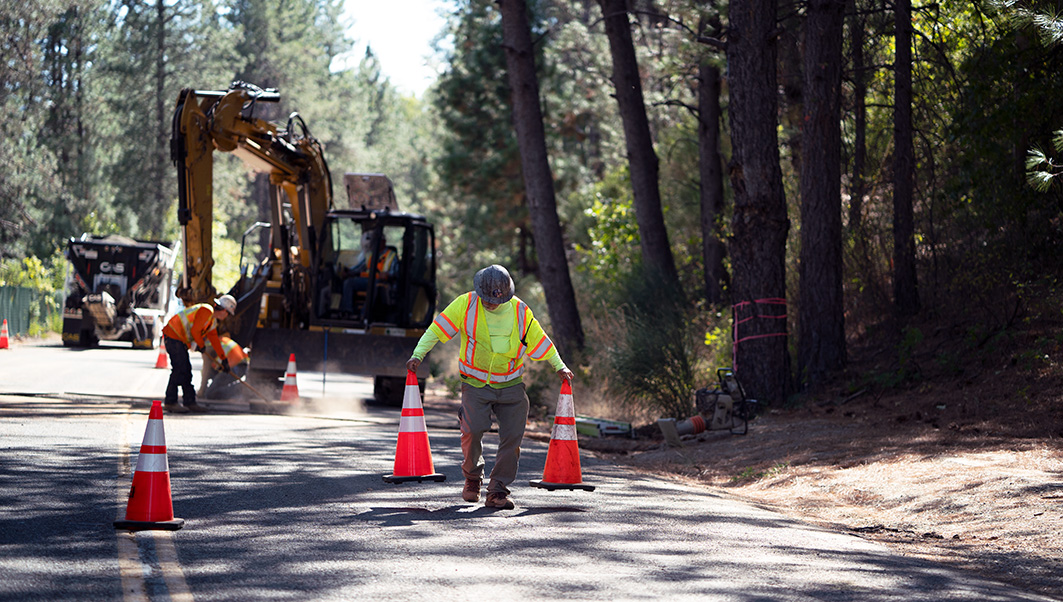
* Phases 1 through 3 may take 1 to 18 months. Phases 4 and 5 may take 2 to 3 months each. Trimming or cutting down trees and shrubs may continue through the entire project from Phase 3 forward.
For your safety, all crews and contractors conducting this work are happy to provide photo ID on request. As this work takes place, you may see PG&E trucks in your area, along with the following contractors:
Learn more about our wildfire safety work
Undergrounding for public safety
Permitting and land rights coordination
The scope of each undergrounding and system upgrade project can vary. This means permitting and easement needs also vary across projects.
- If a permit is needed, PG&E will work with local permitting agencies before moving forward with construction.
- If an easement or land use agreement is needed, PG&E's land team will work directly with individual property owners.
- If you have questions about permitting, easements or land use agreements for work in your area, email undergrounding@pge.com.
Customer and community resources
Undergrounding resources for your county
Additional information or a map is available for each county by clicking the links below:
- Alameda (PDF)
- Amador (PDF)
- Butte
- Calaveras
- Contra Costa (PDF)
- El Dorado
- Fresno (PDF)
- Glenn (PDF)
- Kern (PDF)
- Lake (PDF)
- Madera (PDF)
- Marin (PDF)
- Mariposa (PDF)
- Mendocino (PDF)
- Napa
- Nevada (PDF)
- Placer
- Plumas (PDF)
- San Luis Obispo (PDF)
- San Mateo (PDF)
- Santa Clara (PDF)
- Santa Cruz (PDF)
- Shasta
- Sierra
- Solano (PDF)
- Sonoma (PDF)
- Tehama (PDF)
- Tuolumne (PDF)
- Yuba (PDF)
- All Undergrounding Maps (PDF)
Find information about wildfire safety work in your area by visiting our wildfire safety progress map.
Resources - learn more about this work
Working on a building, renovation, new service, or service relocation project?
Be sure to let us know by calling 1-877-265-1399
Undergrounding and overhead system upgrade videos
Learn more about our undergrounding and system hardening upgrades work by viewing the videos below.
Frequently asked questions
- Find information on planned and completed undergrounding and system upgrades projects on our wildfire safety progress map.
- Find additional maps or information for each county where undergrounding work is planned on the "Undergrounding resources for your county" tab
We will keep you informed if we identify your home or business for wildfire safety work. We may reach out using letters, emails, text messages and phone calls.
If you have any questions, email undergrounding@pge.com or call 1-877-265-1399.
- We are prioritizing undergrounding and system upgrades in high fire-risk areas.
- Because we are focused on reducing wildfire risk, we are not taking community or customer requests for undergrounding or system upgrades as part of this program.
- That said, PG&E does have other non-wildfire safety related programs for moving powerlines underground.
- There is also the Rule 20 (A, B and C) Program.
- These programs allow customers, cities, counties or other individuals to request undergrounding.
- This work is funded by the applicant or in some cases work credits (only agencies can use these work credits).
- These programs prioritize our undergrounding and system upgrades work in areas where we can have the greatest impact on reducing wildfire risk.
- We have already completed more than 1,200 of the nearly 1,900 miles of undergrounding we plan to complete in the highest fire-risk areas by the end of 2027.
- We will continue to work with California regulators to finalize plans for future years.
- This will be done through our long-term undergrounding plan.
- These plans will substantially reduce wildfire risk across our service area.
- We have also completed more than 1,560 miles of the more than 2,000 miles of system upgrades (strong poles and covered powerlines) we plan to install by the end of 2027.
- We will continue to scope work and identify undergrounding and system upgrade miles for future years. Work will first go to the highest-risk circuits.
Undergrounding and system upgrades are just two of the many layers of protection that reduce wildfire risk. We will also:
- Manage trees and shrubs to ensure they grow a safe distance from powerlines.
- Employ our network of weather stations and cameras to better detect extreme weather and wildfires.
- Utilize Enhanced Powerline Safety Settings and more.
To see where many of these layers of protection are in use in your community, visit our wildfire safety progress map.
Distribution powerlines are the smaller powerlines that carry electricity through neighborhoods. Transmission lines are the larger lines that carry power long distances.
Data shows that these distribution powerlines are at a higher wildfire risk than transmission lines. Transmission lines also have larger clear spaces around them from vegetation and on the ground, making wildfire risk lower. This is why PG&E's undergrounding and system upgrade work targets distribution lines.
Of course, PG&E also has strategies to lower wildfire risk on transmission lines. These include:
- Conducting risk-based equipment inspections and repairs.
- Replacing lines when needed.
- Addressing trees and vegetation under and around transmission lines.
- Utilizing powerline safety settings.
- De-energizing lines as needed during Public Safety Power Shutoffs (PSPS).
PG&E is committed to learning and sharing undergrounding best practices to drive safety, efficiency, scale, and continuous improvement. As part of these efforts, in mid-2023 PG&E conducted a survey to 11 other U.S. investor-owned utilities to seek insights on how these utilities have approached undergrounding in the regions they serve.
The benchmarking survey report (PDF) includes background, details, and a summary of the results from the 2023 survey.
Other undergrounding information
PG&E customers may also request electric lines be placed underground through the Electric Tariff Rule 20. It is important to note this is separate from our work to move powerlines underground to reduce wildfire risk.
The Rule 20 tariff is broken into three sections – A, B, and C. These sections have varying project qualifications and levels of ratepayer funding. Learn more about Rule 20.
October 2025: Thousands of PG&E Customers Now Protected from Wildfires as 1,000 Miles of Powerlines are Energized and Underground
October 2025: New Report Again Cites PG&E One of Top Western Utilities for Wildfire Readiness
August 2025: Your Energy Dollars at Work: Meet the New Heavy Hitters in Undergrounding
May 2025: PG&E Proposal Will Power California's Growth and Resilience While Stabilizing Customer Bills
See our progress and future plans
Data as of 12/14/2025
We have reached our goal of moving 330 miles of powerlines underground in 2025. We have now completed more than 1,200 total miles of undergrounding on time and on budget since the announcement of our undergrounding program in 2021.
View planned and completed undergrounding on the wildfire safety progress map.

System upgrade progress
Data as of 12/14/2025
We have exceeded our goal of installing 210 miles of strong poles and covered powerlines in 2025. We have now installed more than 1,560 total miles of strong poles and covered powerlines since we launched our Community Wildfire Safety Program in 2018.
View planned and completed system upgrades on the wildfire safety progress map.

10-Year Electrical Undergrounding Plan (EUP)
SB 884 Expedited Undergrounding Program Discovery/Data Requests
PG&E has responded to discovery or data requests relating to the filing of a 10-year Electrical Undergrounding Plan (EUP) under Senate Bill 884. Each discovery or data request from the California Public Utilities Commission (CPUC) Safety Policy Division (SPD) related to PG&E's EUP is included in the links below.
This page is updated weekly with the latest SPD discovery or data requests and responses.
Updated as of: September 3, 2025
Note: If there are no new responses in a given week, the date will not be updated.
Contact us with issues
Report any accessibility barriers you encounter by contacting undergrounding@pge.com. The mailbox is monitored during our business hours (Monday - Friday; 8 a.m. - 5 p.m.). We will respond within 3 business days.
CPUC Safety Policy Division (SPD)
Responses to IOU Balancing and Memorandum Account
SPD - Data Request 001 (ZIP)
SPD - Data Request 002 (ZIP)
SPD - Data Request 003 (ZIP)
Responses to GRC Depreciation Study Link
SPD - Data Request 004 (ZIP)
Responses to Undergrounding Capital Orders
SPD - Data Request 005 (ZIP)
Responses to Capital Accounting FAQ Documents
SPD - Data Request 006 (ZIP)
Responses to Revenue Requirements Follow-up Questions
SPD - Data Request 007 (ZIP)
Responses to Shared Poles Contracts/Lease Agreements
SPD - Data Request 008 (ZIP)
Responses to WMP Cost Reporting Template
SPD - Data Request 009 (ZIP)
Responses to Undergrounding Project Phases and Project Documents
SPD - Data Request 010 (ZIP)
SPD - Data Request 013 (ZIP)
SPD - Data Request 015 (ZIP)
SPD - Data Request 016 (ZIP)
Responses pertaining to PG&E's Mini-RO Models
SPD - Data Request 011 (ZIP)
SPD - Data Request 012 (ZIP)
Responses pertaining to External Funding
SPD - Data Request 014 (ZIP)
Responses pertaining to PG&E's Wildfire Benefit Cost Analysis Tool
SPD - Data Request 017 (ZIP)
SPD - Data Request 018 (ZIP)
Responses pertaining to PG&E's filing timeline
SPD - Data Request 020 (ZIP)
Contact us
Program contact information
For any questions related to undergrounding or installing strong poles and covered powerlines, email undergrounding@pge.com or call 1-877-265-1399. We will get back to you within 3-5 business days.
Vendor information
If you are a vendor interested in being added to our list, please complete the Contractor Contact Form.
Services of interest may include, but are not limited to:
- Electric construction services
- Civil construction services
- Engineering services
- Engineering, procurement, and construction services
- Other relevant support services
- Electric materials
Questions
Call the PG&E Undergrounding and System Upgrades Team at 1-877-265-1399 or email us at wildfiresafety@pge.com. Responses typically take 3-5 business days.
More on outages and safety
Outage preparedness and support
Stay prepared for power outages and get support.
Community Wildfire Safety Program (CWSP)
Find out how PG&E is making our system safer and more reliable.
©2025 Pacific Gas and Electric Company
©2025 Pacific Gas and Electric Company



